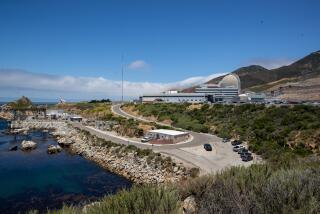Government faces setbacks on 2 fronts in handling radioactive waste
- Share via
The Energy Department, dealing with twin setbacks in its long effort to deal with Cold War-era radioactive waste, said Tuesday it was stopping construction of a massive plant in South Carolina to handle surplus plutonium and proceeding with an investigation into a leak at a nuclear dump in New Mexico that exposed 13 workers to airborne plutonium.
In releasing its fiscal 2015 budget, energy officials said they were stopping construction of the “mixed oxide fuel” plant at the Savannah River site in South Carolina. “The cost has gotten way beyond what we could ask taxpayers for in these tight times,” said officials at the National Nuclear Security Administration, a unit of the Energy Department.
The facility, which is more than half completed, was originally supposed to cost $4.8 billion, and the most recent construction cost estimate put it at $7.7 billion. The department has already spent $3.9 billion on the project, and the total projected cost for the plant hit $30 billion, including future operations.
The plant was intended to convert 34 tons of surplus bomb-grade plutonium into fuel for commercial reactors.
The U.S. and Russia each agreed to reduce their plutonium stocks by the 34 tons, but the decision to put the South Carolina facility into a “cold shutdown” will require a new round of talks between the two countries.
“At the right time, we will both have to engage in those discussions, but now is not the right time,” said Energy Secretary Ernest J. Moniz, apparently referring to the standoff over Russian forces in Ukraine.
Critics asserted that nuclear utilities did not even want the plutonium fuel, because of all the potential security concerns associated with bomb materials.
Meanwhile, energy officials said Tuesday they had no estimate yet of how long the radioactivity dump in New Mexico, called the Waste Isolation Pilot Plant, would be closed after a leak last month released plutonium and americium into underground tunnels that eventually reached the surface. They also could not say how much the eventual cleanup of the release would cost.
Incoming shipments of waste from about a dozen cleanup projects across the nation, including the Lawrence Livermore National Laboratory in the San Francisco Bay Area, are being stored in a parking lot at the dump site. Under a state agreement, the drums can be stored there for only 30 days, but New Mexico officials say they may grant waivers.
The accident is causing a backlog of plutonium and other synthetic radioactive elements heavier than uranium to build up at nuclear weapons sites or cleanup sites across the nation.
In the days after the incident, the department said several times that no workers were affected, but last week it disclosed that 13 workers had been exposed.
In a statement to The Times, the department said, “The WIPP facility has not yet reopened after the recent radiological event. We will not know the duration of the shutdown or the related impacts until after we have safely reentered the underground facility and have completed the investigation. DOE is working with [waste] generator sites and analyzing options to minimize the impact of the WIPP event on other sites.”
More to Read
Sign up for Essential California
The most important California stories and recommendations in your inbox every morning.
You may occasionally receive promotional content from the Los Angeles Times.











